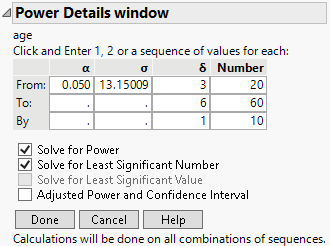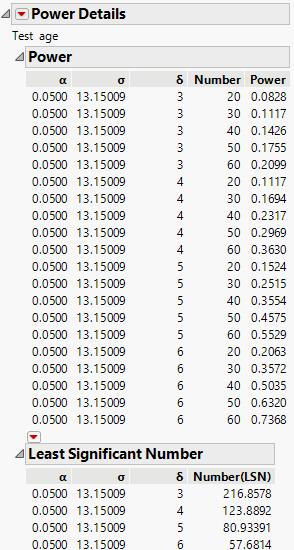Example of Retrospective Power Analysis
Use the Standard Least Squares personality of the Fit Model platform to fit a linear regression model and perform a retrospective power analysis. This example illustrates a retrospective power analysis. The Power Details window enables exploration of various quantities over ranges of values for α, σ, δ, and Number, or study size. When you click Done, the Power Details window is replaced with the results of the calculations.
1. Select Help > Sample Data Folder and open Big Class.jmp.
2. Select Analyze > Fit Model.
3. Select weight and click Y.
4. Select age, sex, and height and click Add.
5. Click Run.
6. Click the age red triangle and select Power Analysis.
7. Replace the δ value in the From box with 3, and enter 6 and 1 in the To and By boxes, as shown in Figure 4.57.
8. Replace the Number value in the From box with 20, and enter 60 and 10 in the To and By boxes, as shown in Figure 4.57.
9. Select both Solve for Power and Solve for Least Significant Number.
Figure 4.57 Power Details Window for Age
10. Click Done.
The Power Details window is replaced by the Power Details report.
Figure 4.58 Power Details Report for Age
This analysis is a retrospective power analysis because the calculations are based on the data already collected. For example, the calculation of power in this example depends on the effects entered into the model and the number of participants in each age and sex grouping. Also, the value of σ was derived from the current study, though you could have replaced it with a value that would be representative of a future study.
For more information about the power results in this example, see “Power”. For more information about the least significant number (LSN), see “The Least Significant Number (LSN)”.

